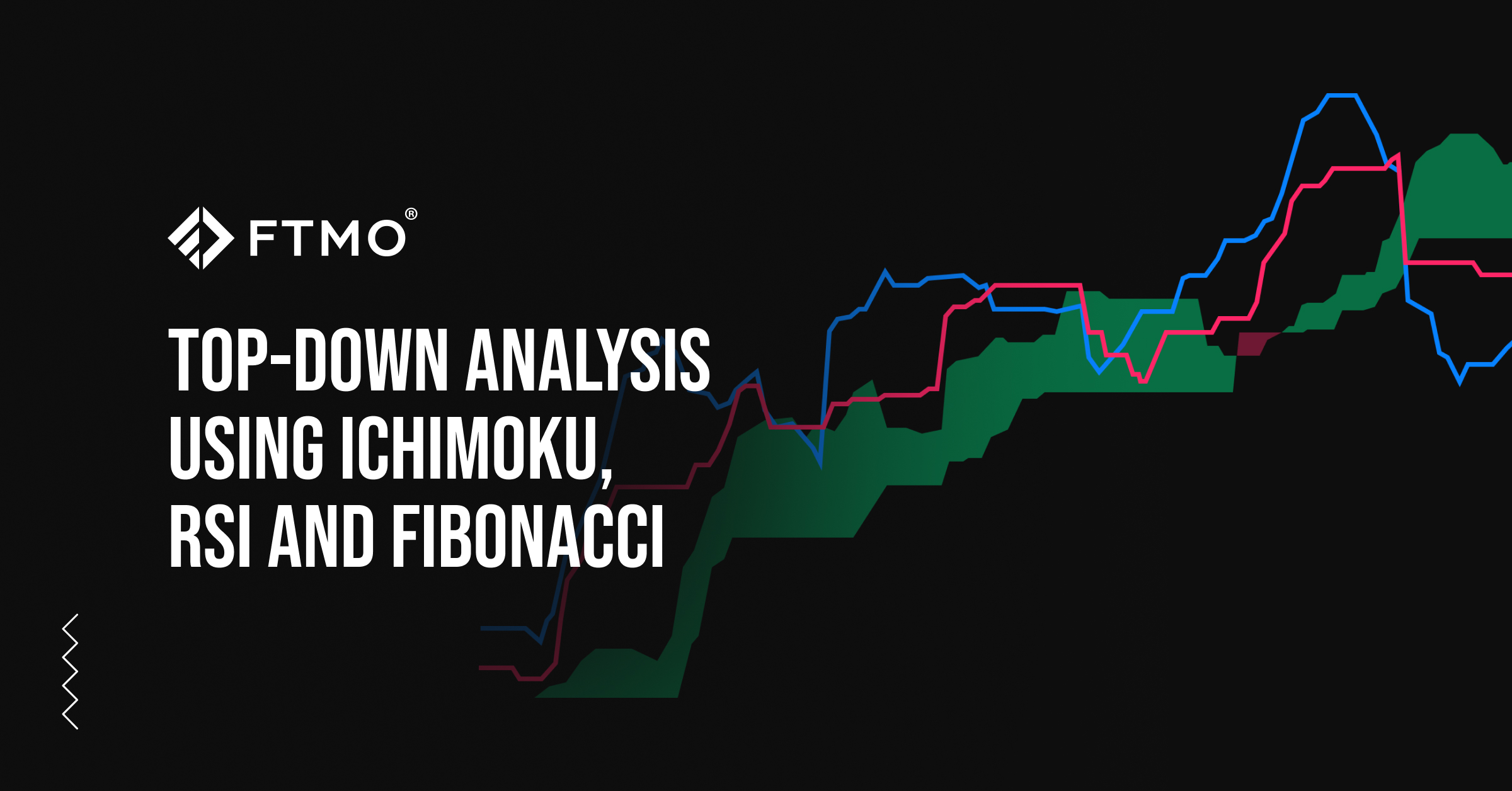
Top-down analysis using Ichimoku, RSI and Fibonacci
We are introducing a sophisticated trading strategy that combines technical analysis with the use of several advanced indicators and multi-timeframe analysis. The strategy focuses on the effective identification of the main trend, corrections and the precise timing of entries and exits.
The key components of the described strategy are Ichimoku Kinko Hyo (Ichimoku Cloud), Relative Strength Index (RSI) and Fibonacci retracement, which together enable a comprehensive market analysis and increase the probability of success. At the very end, we will also look at a specific example of this strategy.
The strategy uses the following technical indicators and concepts
Ichimoku Kinko Hyo (Ichimoku Cloud) provides a comprehensive overview of market conditions, including current trend, support, resistance and future market direction. Ichimoku Cloud includes several components:
The Kijun Sen (red line) is also known as the baseline, which is calculated by averaging the lowest low and highest high over the last 26 periods.
Tenkan Sen (blue line) is also known as the conversion line, which is calculated by averaging the lowest low and highest high over the last 9 periods.
The Chikou Span (green line) is also known as the lagging line. It shows the closing price delayed by 26 periods.
The Ichimoku Cloud consists of two Senkou Span lines that serve as the borders of the cloud. The first line is calculated as the average of the Tenkan Sen and Kijun Sen and is plotted 26 periods ahead. The second line is calculated as the average of the lowest minimum and highest maximum over the last 52 periods and plotted 26 periods ahead.
The Relative Strength Index (RSI) is an oscillator that measures the strength and speed of price changes over a period of time. RSI values above 70 indicate an overbought market, while values below 30 indicate an oversold market.
Fibonacci retracement and expansion are key horizontal lines that identify possible support and resistance levels based on previous price movements. The Fibonacci retracement (38.2%, 50%, 61.8%) is typically used to identify possible corrections, while the Fibonacci expansion (161.8%) can serve as a target level for exiting a position.
Multi-timeframe analysis (top-down analysis) allows traders to analyse the market on several timeframes simultaneously. The main trend is identified on the higher time frame (e.g. daily chart), while position entries are timed on the lower time frame (e.g. 1H chart).
Trading strategy rules
Step 1: Identify the trend on a higher time frame using Ichimoku Cloud.
On a higher timeframe (e.g. daily chart) we analyse the overall trend using Ichimoku Cloud. A price above the cloud indicates an increasing trend, while a price below the cloud indicates a decreasing trend. This step allows us to identify the main direction of the market, which is crucial for timing the entry on the lower timeframe.
Step 2: Fibonacci retracement to identify corrections.
After identifying the main trend, we apply Fibonacci retracement on the higher time frame to identify key support and resistance levels. The 38.2%, 50% and 61.8% levels represent important zones where market corrections can occur and therefore opportunities for position entry.
Step 3: Confirm entry on the lower timeframe using the RSI and Ichimoku Cloud.
On the lower timeframe (e.g. 1H chart) we are looking for confirmation of the trend and market strength. The price must be above the cloud (for long positions) or below the cloud (for short positions), while the RSI must be in a favourable range:
- For a long position: the RSI should be in the range of 30-50, indicating a weaker market with upside potential.
- For a short position: the RSI should be in the 50-70 range, indicating that the market may be overbought and likely to decline.
Step 4: Entering the trade and managing risk.
Once the above conditions are met, we enter the order. We set the Stop Loss below/above the significant Ichimoku Cloud or Fibonacci retracement levels. To ensure profitability, we also use Trailing Stops based on Fibonacci expansion or other technical levels, or we may use fixed RRRs, etc.
Step 5: Exit the trade.
To exit the position, we watch for key Fibonacci levels (e.g. 161.8% expansion) or overbought/oversold signals on the RSI. Exiting a long position occurs when the RSI reaches the 70 level or price reaches Fibonacci expansion, indicating a possible change in direction. However, exits can be handled in other ways, depending on the trader's preference.
Practical example
The trading example shows the application of this strategy on the EURJPY pair.
1, Trend identification: On the daily chart of EURJPY the price broke above the Ichimoku Cloud, indicating an uptrend. We apply the Fibonacci retracement to the last upward movement and find that the support level, represented by the so-called cloud, is located between the 38.2% and 50% Fibonacci retracement levels.

2, Entry Confirmation: after price tested the 38.2% Fibonacci retracement level on the D1 chart, and the RSI indicator dropped below 30 on the H1 chart, indicating an oversold pattern within the uptrend. At the same time, the price is starting to rise above the Ichimoku Cloud.
3, Position entry: based on confirmation, we enter a long position at around 160.9 to 161.0. We set the stop-loss below the Fibonacci level of 38.2% (158.5) to protect capital in case of a failure.

The SL will therefore be 250 to 300 pips in points and the TP can be set according to the Fibonacci expansion at 161.8% (level around 167.24) or 176.4% (168.51), or according to the RRR (at least 2:1, ideally more).
4, Exit position: The price moves in the direction of the expected trend and reaches TP at Fibonacci expansion levels of 161.8% (profit 624 pips), and also 176.4% (751 pips). RSI also reaches 70, indicating overbought condition.

Conclusion
This strategy, based on a combination of advanced technical indicators and multi-timeframe analysis, provides traders with an effective tool for accurately timing trade entries and exits. The use of Ichimoku Cloud as the main trend indicator in combination with RSI and Fibonacci levels allows for effective risk management and maximisation of profits. This strategy is suitable for more experienced traders looking for a more sophisticated approach to trading.
All information provided on this site is intended solely for educational purposes related to trading on financial markets and does not serve in any way as a specific investment recommendation, business recommendation, investment opportunity analysis or similar general recommendation regarding the trading of investment instruments. FTMO only provides services of simulated trading and educational tools for traders. The information on this site is not directed at residents in any country or jurisdiction where such distribution or use would be contrary to local laws or regulations. FTMO companies do not act as a broker and do not accept any deposits. The offered technical solution for the FTMO platforms and data feed is powered by liquidity providers.
About FTMO
FTMO has developed a two-step evaluation process to find trading talents. Upon successful completion, you may be eligible for an FTMO Rewards Account with a balance of up to $200,000 in simulated funds. How does it work?














